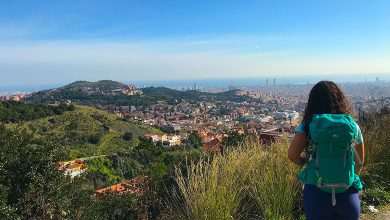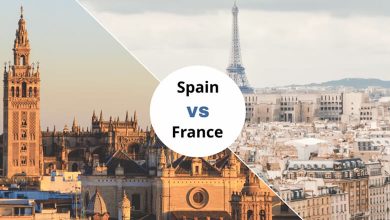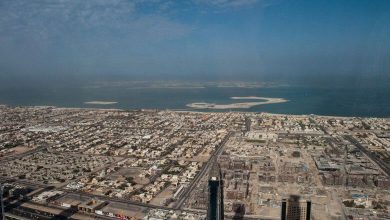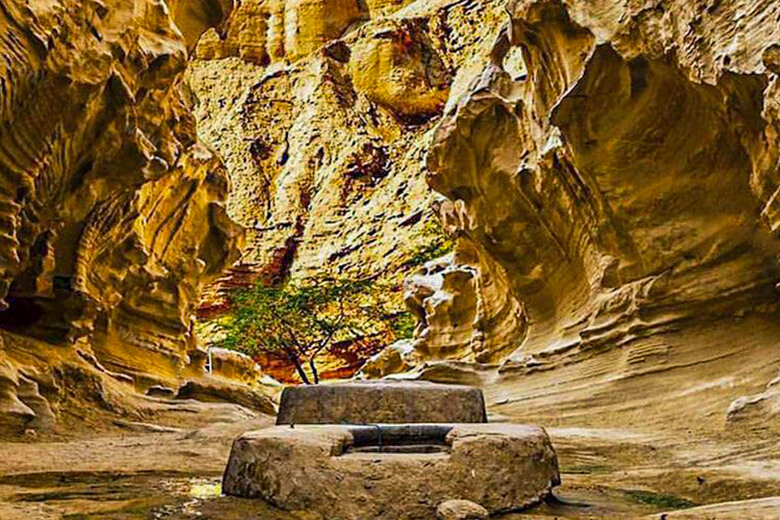
Qeshm is a magical island in Iran located on the coastlines of the Persian Gulf with so many attractions and scenery that amazes every traveler that comes to this wonderland situated on the strait of Hormoz. 31 picturesque and valuable landmarks were collected and recognized by UNESCO.
A collection of 31 main natural sites of Qeshm were collected under the name of Qeshm Geopark. These 31 sites are very valuable to the nature of the earth and to quote UNESCO itself, they are valued and chosen to celebrate Earth’s heritage.
Qeshm geopark is a collection of this island’s most spectacular sites located on the mountain belt of Zagros. In this article, we are going to talk about Qeshm Geopark and introduce this magnificent landmark.
ALL Qeshm Geopark’s 31 Geosites (geoparks)
Qeshm Geopark is a belt of 31 pristine sites that are located next to each other. These 31 lands were recognized by UNESCO so you can trust the fact that they are worthy of visiting. Continuing we will name every geosite in Qeshm Geopark and share a brief profile about every one of them.
- The valley of stars
- Basira
- Korkora Kooh
- The valley of statues
- Namakdan (salt) cave
- Bame e Qeshm (the roof of Qeshm)
- Chahkooh Gorge (canyon)
- Darre Shur (shour valley)
- Mangrove (Hara) forests of Qeshm
- Portuguese castle
- Hengam island
- Naz islands
- Geolink
- Left Village
- Museum of Geopark
- Kharbas Cave
- Mud Flat
- Chakavir
- Awli Gorge
- Dolphins Bay
- Ghazi Terrace
- Basaeidou
- Turtles Nesting Beach
- Crabs Rock
- Guran Park museum
- Kooh Kalengi
- Jaziratoo
- Dokalan
- Karyon
- Kargah Beach
- Dokouhak Bird’s wetland
The valley of stars
This valley is located outside the Qeshm Geopark area but they put it on the list because of its magnificent and unique architecture. This place is more than 2 million years that you will not see a lookalike place to it on earth. Natural causes like rain and wind have made erosion in this valley and created holes in the rocks of this place and unique architecture.
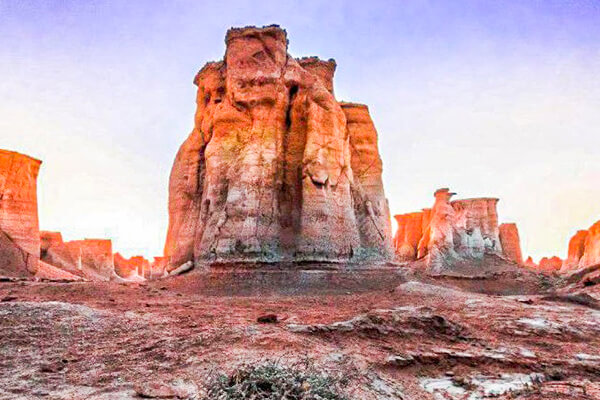
Basira
Basira is another geosite on Qeshm Geopark located between Gori and Morad villages. This special land is a wide landscape filled with high hills that are shaped like a wall that have surrounded this place.
Basira landscape has a large distance from modern cities and homeland so it’s far away from light pollution. This distance has created a magical place where you can lie under the sky and watch stars.
Korkora Kooh (mountain)
On the middle part of Qeshm island and the eastern part of Giahdan village, you will find another site of Qeshm geopark’s sites with stunning structures and architecture that was also created by natural phenomena and erosion.
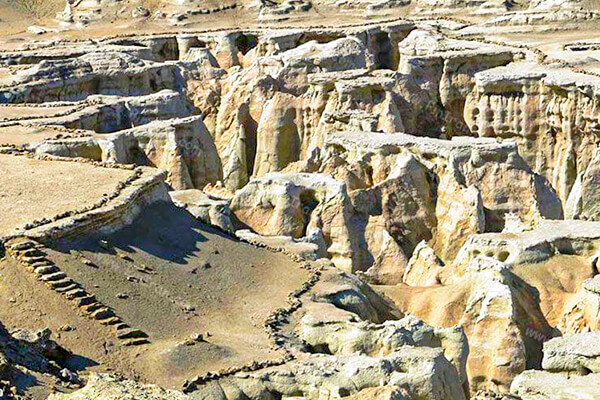
Chakavir Valley
One of the picturesque geosites in Qeshm Geopark is Chakavir valley which is located in Goran village, 92 kilometers away from the central part of Qeshm island. The water and its moves have created a gorgeous shape inside the Chakavir valley through erosion.
There are several holes in Chakavir Valley where the rainwater fills them and creates a beautiful blue glow inside them which is perfectly matched with the gray and white color of the rocks.
The valley of statues
This valley is another natural site on Qeshm geopark’s list of sites with a striking structure. The valley of statues structure is very much like the valley of stars but with a larger land area. rain, wind, and other natural phenomena have formed the rocks of this valley into various shapes through erosion. The rocks are in the shape of animals and there are some narratives about this theurgic landmark in the island’s folklore.

Kargah Beach
Kargah beach is a coast with more than 5 kilometers of coastline. This seashore is one of the most pristine beaches on Qeshm island with a variety of species. Kargah Beach is a sandy beach with a valuable ecology.
The unique ecology of Kargah helped this place to get recognized by UNESCO as a geosite in the Qeshm geopark. Geolink is the nearest geosite to Kargah Beach.
Namakdan (Salt) cave
Namakdan cave is the largest salt cave in the world and one of Qeshm Geopark’s most known sites. There’s a dome made of salt in this place that holds the Namakdan cave inside of it. The Namakdan salt cave is very old and you can see the various layers of salt in there and every layer has a different color. Locals believe that this place is helpful for some sicknesses and can be helpful.
This place is open every day of the week from 8 AM to 8 PM.
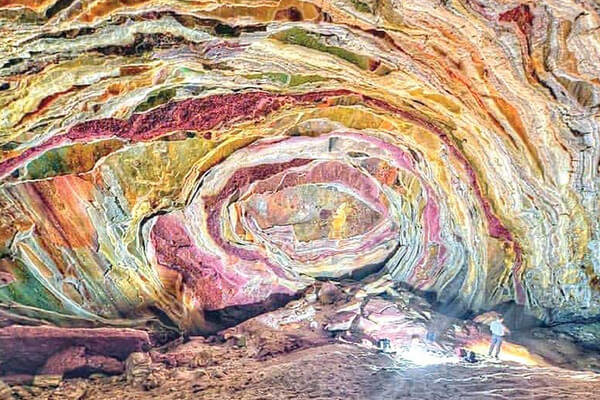
Awli Gorge
Awli Gorge is another geosite in Qeshm Geopark with a pristine structure. This magnificent gorge is a phenomenon in Geology where you will be amazed by its beauty and glory.
Although Qeshm is full of deserts and dry lands, this gorge is full of trees and plants which is a sign that unlike other zones of Qeshm island there’s more than plenty of water in this gorge.
Bam Qeshm (the roof of Qeshm)
Bam Qeshm also known as the roof of Qeshm is a fascinating landscape and one of the most beautiful sites on the Qeshm geopark’s list. The roof of Qeshm holds an important place on the Qeshm geopark’s list and you can consider it as the mainland of the area. Because it provides a panoramic view of other geosites and has the highest spot on the island.
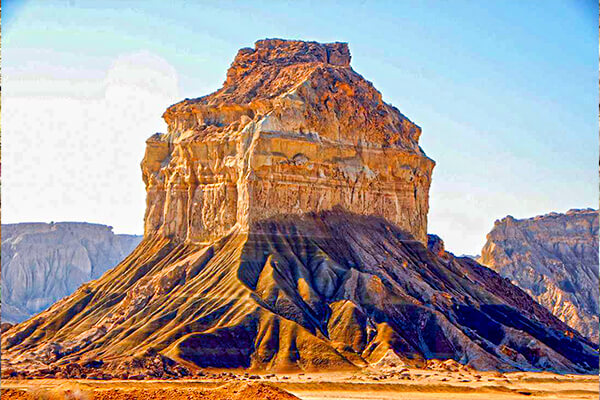
Basaeidou
Basaeidou is a village near the Qeshm city of Qeshm island and one of Qeshm Geopark’s geosites. This village was the latest land area in Qeshm that the English and Portuguese governments left.
Basaeidou village is full of rare species, gorgeous landscapes, and historical places. You can get a glance at Qeshm island’s history in this village. A Portuguese castle which is a distinct geosite is located in this village.
Chahkooh Gorge (canyon)
Chahkooh is another site on Qeshm geopark’s list and a fascinating landmark in the land of wonders, Qeshm island. this gorgeous place on Qeshm island is a canyon or gorge with a special structure that were caused by natural phenomenon including rain and wind.
As you are walking in this place you will see rock formations with fascinating shapes and structures. There are wells in this canyon that were made and dug by humans for watering their animals. These wells were used as reservoirs for saving rainwater on rainy days.
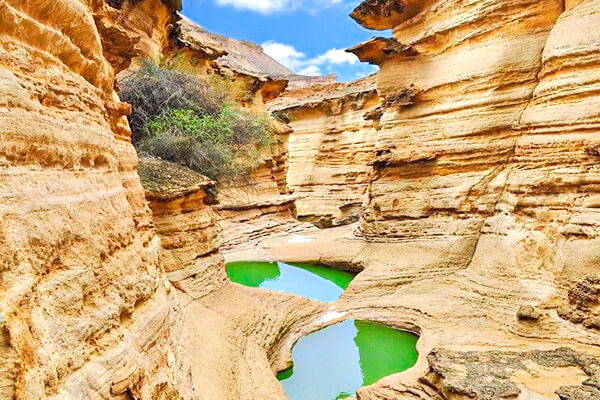
Guran Park museum
Another geosite that was recognized and chosen by UNESCO in Qeshm geopark is the Guran park museum in Guran village. Guran village is a village with a long history located in the west of Qeshm island. this village has a long history of making boats and the maritime industry.
Make sure you visit this interesting museum on your visit to Qeshm island to learn about the importance of the maritime industry in the history of Qeshm island.
Darre Shur
Darre Shur is another site of Qeshm Geopark’s many geosites that is one of the unexplored and unknown landmarks on this island. the reason that this picturesque landmark stays unknown is the distance that it has from Qeshm island. this valley is next to Salakh village and it is located in the center of an anticline. The oldest sedimentary layers of Qeshm island were found in this valley which adds to its importance.
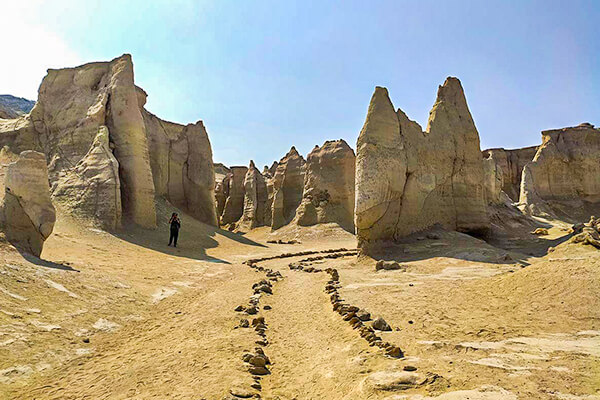
Dokalan
Dokalan is another recognized geosite in the Qeshm geopark. Dokalan is a region full of striking phenomena that were created by erosion. This geosite is located in the western part of Qeshm island, near the Gouran village that we mentioned earlier.
Mangrove (Hara) forests of Qeshm
The evergreen forest of Qeshm island is called Hara forest and this spectacular place is a forest in the middle of Persian Gulf waters. The mangrove or Hara forest of Qeshm is one of the several geosites of Qeshm geopark that you should definitely visit on your trip to Qeshm island. you have to visit this place by boat or a motorboat. As you pass by the trees you will see woods that came out of the water which are actually the roots of trees. These trees were able to stay alive and green through centuries by turning the salty waters of the Persian Gulf into fresh water and using them for photosynthesis.

Jaziratoo
There are some parts of Qeshm island where you can only see them at low tide. One of these places is Jaziratoo which is a rocky coast located on Qeshm island and recognized as a geosite in Qeshm geopark.
This rocky habitat has provided an ideal homeland for both land and marine species. So, you will see various kinds of species in this region.
Portuguese castle
Most sites on the Qeshm geopark’s list are natural sites but the Portuguese castle is a historical site that remained from the 16th and 17th centuries. This castle is a fortress and a relic from the attack of the Portuguese army on the southern lands of Iran. This historical site is a vestige from the time that Portuguese people took over the island. you can see the history and the natural beauty of the island at the Portuguese castle.
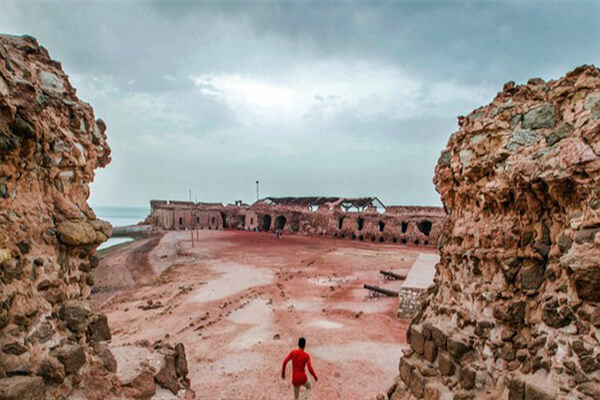
Karyon Gorge
There are some narrow and long canyons that are located in a parallel line on the western part of Qeshm island. there are all forms of erosion in this canyon and rock layers that have been shaped throughout centuries.
At Karyon Gorge you will see all kinds of natural phenomena that all together have created a unique landscape and ecosystem.
Hengam island
The magnificent island of Hengam is a small island near Qeshm island and one of Qeshm geopark’s many geosites. Every one of these geosites is charming and magnificent in its own way and Hengam island is no exception. This island is a collection of attractions itself. You can visit a number of attractions on Hengam island and spend a day of your trip in this charming place.
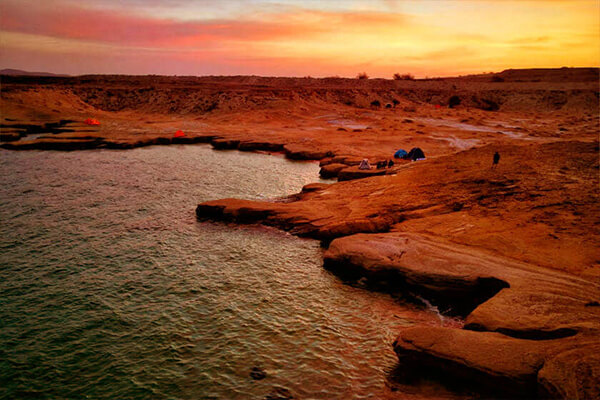
Kooh kalengi
Kooh Kalengi is one of the most recently added geosites to Qeshm Geopark’s collection. This mountain or if you call it “Kooh” which means mountain in the Persian language is located in the center of the Island.
Mount Kalengi or Kooh Kalengi is a mountain where all its land and ground are filled with fossils. This interesting landscape amazes every visitor.
Naz islands
Naz island is an archipelago that contains two islands located one kilometer away from Qeshm island in the waters of the Persian Gulf. These two magical islands are one of the most glamorous places that you can visit on this island and one of the most beautiful geosites on the Qeshm geopark list. These tidal islands provide the best spot for sightseeing Persian Gulf, the strait of Hormoz, Larak island, and the coastline of Qeshm island.
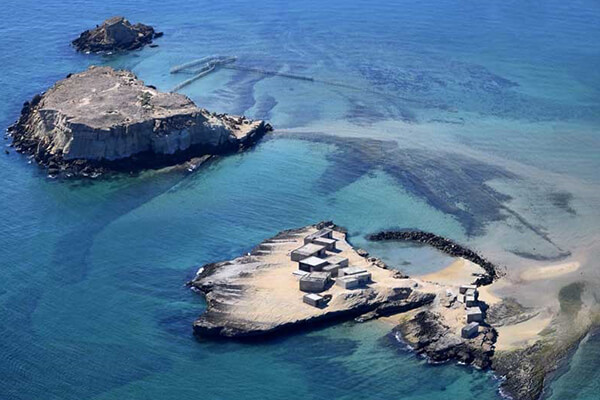
Geolink
Geolink is an area between Darre Shur and Namakdan cave that is located on the southern part of the Salakh anticline. This place is considered a distinct site from those two because of its special structure and natural phenomena that you can find in this area.
You can see the affection that erosion has on natural landmarks in this place and visit the deceptive shapes and structures that were made by the erosion. You can also see the amazing marine habitats that you can find on the shoreline of the Persian Gulf and Qeshm island.
Laft Village
Laft village is another site of Qeshm geopark that is one of the most popular tourist attractions and destinations among visitors of Qeshm island. this village is mostly historical and full of relics that are informing you about the importance of Qeshm island.
You will see that this island has been through a lot in history and despite the magnificent scenery, it has a lot to offer about its heritage and history. This village is also one of the places where you can visit the Hara forests of Qeshm from.
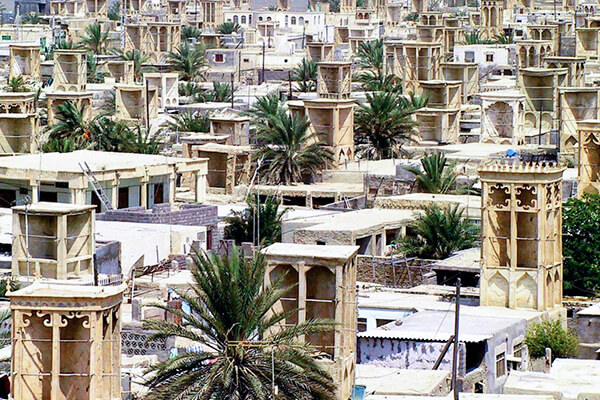
Museum of Geopark
Museum geopark is recognized as one of the Qeshm geopark’s geosites. This must-visit attraction on Qeshm island is a museum that showcases more than 3000 specimens that are mostly focused on the geological and biological information of Qeshm island.
You can visit the world’s smallest and biggest mammals taxidermied in the museum geopark. You have to put a visit to this place in your trip plan to Qeshm island because it informs you about the geological and historical biography of the island.
Kharbas Cave
Kharbas Cave is important in both geological and historical ways and is one of the Qeshm geopark’s geosites. This historic site dates back to the Medes which is surrounded by tall and short coral reefs. This pristine cave is located on the mountain belt of Zagros with charming architecture that will amaze you with its beauty.
You are able to visit this cave every day of the week from 6 AM to 8 PM.
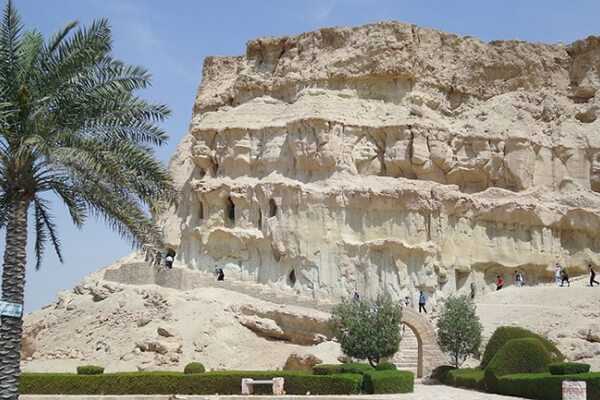
Mud Flat
There are several mud flats on Qeshm island that are one of the most sensitive ecosystems on this island. But on the northern coast of this island, there’s a large mud flat that has provided an ideal homeland for numerous aquatic organisms and marine species.
There’s a valuable food chain the Mudflats of Qeshm island which are one of the main reasons for UNESCO to register them as an important landscape and to register them as one of the geosites of Qeshm Geopark.
Dolphins Bay
The coasts of Qeshm island are an ideal homeland for all kinds of marine species. The variety of ecosystems has provided a land full of biodiversity on Qeshm island. this diversity is mostly seen in marine species and lifestyles.
One kind of valuable and interesting species that you see on Qeshm’s coasts is dolphins. These beautiful animals are a wonder in the food chain in the latest stages of this chain. You can meet several kinds of this cute species on the coasts of Qeshm island.
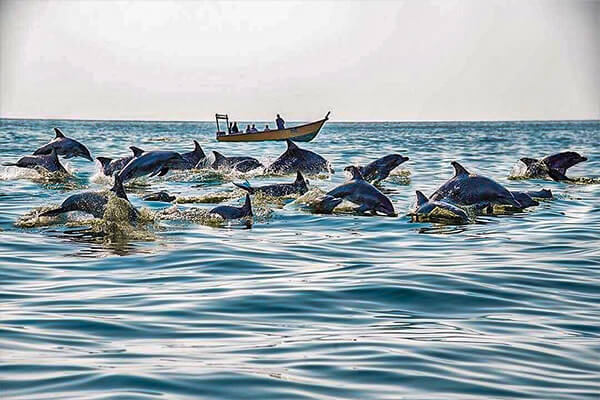
Ghazi Terrace
Ghazi Terrace is one of the most pristine and natural geosites in Qeshm Geopark which is a wonderland for geology students and researchers. The pristine landscapes and natural phenomena on the Ghazi terrace are very rare on earth.
The glamorous sights Ghazi terrace is the reason that every year a lot of Iranian and foreign tourists from other countries come to visit this fabulous landscape.
Turtles Nesting Beach
Turtles nesting beach is Shib Deraz village’s coast which is another geosite in Qeshm Geopark. This beach is the mainland for nesting and laying eggs of Hawksbill turtles which are an endangered kind of species.
The project of protecting the spawning beach of Hawksbill turtles started in 2002 and it is one of the top 10 successful environmental projects worldwide. Because of the danger of extinction that faces this specie, you can’t walk on the coast. You are only allowed to visit this coast with the coordination of the site authorities.
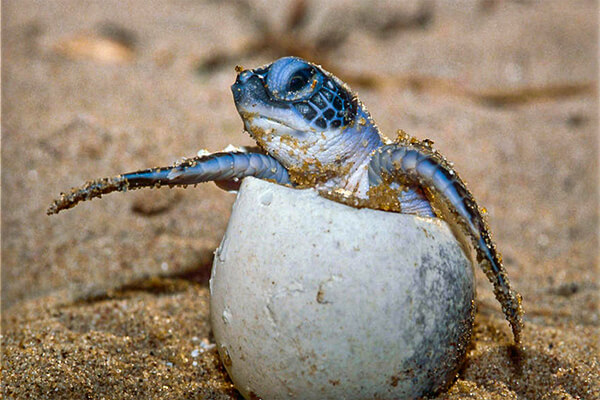
Crabs Rock
Crabs rock is another interesting landscape in Qeshm island which is also one of Qeshm geopark’s geosites. Various kinds of marine species live in this place but as you may have already noticed from the name, marine crabs are the symbol of this region.
Different layers of marine sediment have shaped this geosite and created a homeland for marine crabs and other species. You can see the beautiful sigh that natural causes have created in this place as well as the cute and wonderful marine species.
Dokouhak Bird’s wetland
Dokouhak Bird’s wetland is another geosite in Qeshm Geopark which is the homeland of more than 120 kinds of marine species. Every year a large number of migratory birds come to this wetland and you can see them flying over this glamorous landmark.
Final words about Qeshm geopark
The Qeshm Geopark is a collection of Qeshm’s most pristine and picturesque attractions that were registered by UNESCO. These landmarks are an honor to this land and earth that every visitor should be pleased to visit them. This collection is actually a collection of Qeshm’s tourist attractions that you can plan your trip to Qeshm based on it.
